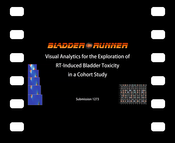Information
- Publication Type: Journal Paper with Conference Talk
- Workgroup(s)/Project(s):
- Date: 2018
- Journal: Computer Graphics Forum
- Volume: 37
- Number: 3
- Lecturer: Renata Raidou

- ISSN: 1467-8659
- Event: EuroVis 2018
- DOI: 10.1111/cgf.13413
- Pages: 205-216
- Conference date: June 2018
- Pages: 205 – 216
Abstract
We present the Bladder Runner, a novel tool to enable detailed visual exploration and analysis of the impact of bladder shape variation on the accuracy of dose delivery, during the course of prostate cancer radiotherapy (RT). Our tool enables the investigation of individual patients and cohorts through the entire treatment process, and it can give indications of RT-induced complications for the patient. In prostate cancer RT treatment, despite the design of an initial plan prior to dose administration, bladder toxicity remains very common. The main reason is that the dose is delivered in multiple fractions over a period of weeks, during which, the anatomical variation of the bladder - due to differences in urinary filling - causes deviations between planned and delivered doses. Clinical researchers want to correlate bladder shape variations to dose deviations and toxicity risk through cohort studies, to understand which specific bladder shape characteristics are more prone to side effects. This is currently done with Dose-Volume Histograms (DVHs), which provide limited, qualitative insight. The effect of bladder variation on dose delivery and the resulting toxicity cannot be currently examined with the DVHs. To address this need, we designed and implemented the Bladder Runner, which incorporates visualization strategies in a highly interactive environment with multiple linked views. Individual patients can be explored and analyzed through the entire treatment period, while inter-patient and temporal exploration, analysis and comparison are also supported. We demonstrate the applicability of our presented tool with a usage scenario, employing a dataset of 29 patients followed through the course of the treatment, across 13 time points. We conducted an evaluation with three clinical researchers working on the investigation of RT-induced bladder toxicity. All participants agreed that Bladder Runner provides better understanding and new opportunities for the exploration and analysis of the involved cohort data.
Additional Files and Images
Additional images and videos
Additional files
Weblinks
BibTeX
@article{raidou_2018_bladderrunner,
title = "Bladder Runner: Visual Analytics for the Exploration of
RT-Induced Bladder Toxicity in a Cohort Study",
author = "Renata Raidou and Oscar Casares-Magaz and Aleksandr
Amirkhanov and Vitali Moiseenko and Ludvig Paul Muren and
John P. Einck and Anna Vilanova i Bartroli and Eduard
Gr\"{o}ller",
year = "2018",
abstract = "We present the Bladder Runner, a novel tool to enable
detailed visual exploration and analysis of the impact of
bladder shape variation on the accuracy of dose delivery,
during the course of prostate cancer radiotherapy (RT). Our
tool enables the investigation of individual patients and
cohorts through the entire treatment process, and it can
give indications of RT-induced complications for the
patient. In prostate cancer RT treatment, despite the design
of an initial plan prior to dose administration, bladder
toxicity remains very common. The main reason is that the
dose is delivered in multiple fractions over a period of
weeks, during which, the anatomical variation of the bladder
- due to differences in urinary filling - causes deviations
between planned and delivered doses. Clinical researchers
want to correlate bladder shape variations to dose
deviations and toxicity risk through cohort studies, to
understand which specific bladder shape characteristics are
more prone to side effects. This is currently done with
Dose-Volume Histograms (DVHs), which provide limited,
qualitative insight. The effect of bladder variation on dose
delivery and the resulting toxicity cannot be currently
examined with the DVHs. To address this need, we designed
and implemented the Bladder Runner, which incorporates
visualization strategies in a highly interactive environment
with multiple linked views. Individual patients can be
explored and analyzed through the entire treatment period,
while inter-patient and temporal exploration, analysis and
comparison are also supported. We demonstrate the
applicability of our presented tool with a usage scenario,
employing a dataset of 29 patients followed through the
course of the treatment, across 13 time points. We conducted
an evaluation with three clinical researchers working on the
investigation of RT-induced bladder toxicity. All
participants agreed that Bladder Runner provides better
understanding and new opportunities for the exploration and
analysis of the involved cohort data.",
journal = "Computer Graphics Forum",
volume = "37",
number = "3",
issn = "1467-8659",
doi = "10.1111/cgf.13413",
pages = "205-216",
pages = "205--216",
URL = "https://www.cg.tuwien.ac.at/research/publications/2018/raidou_2018_bladderrunner/",
}

 Paper
Paper Video
Video
